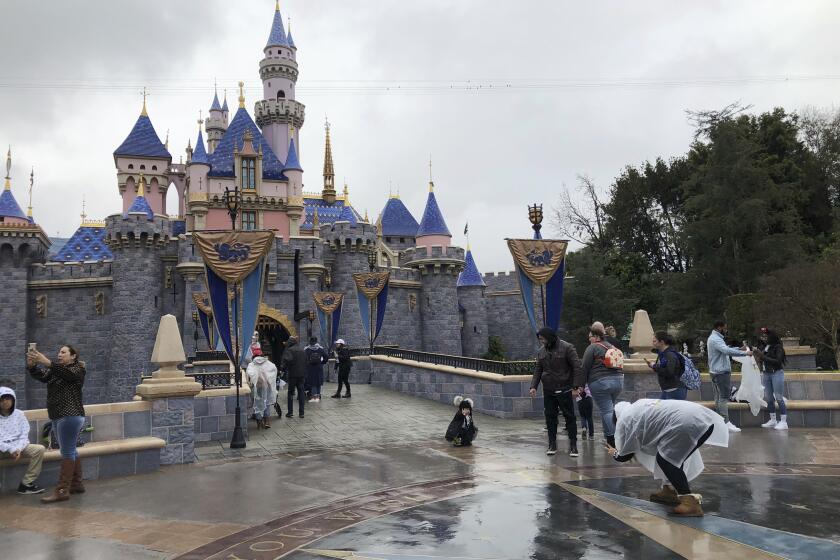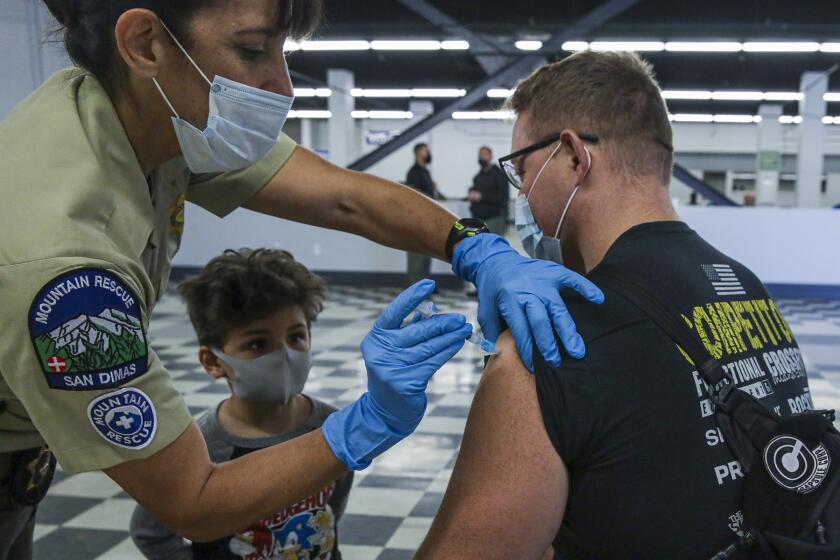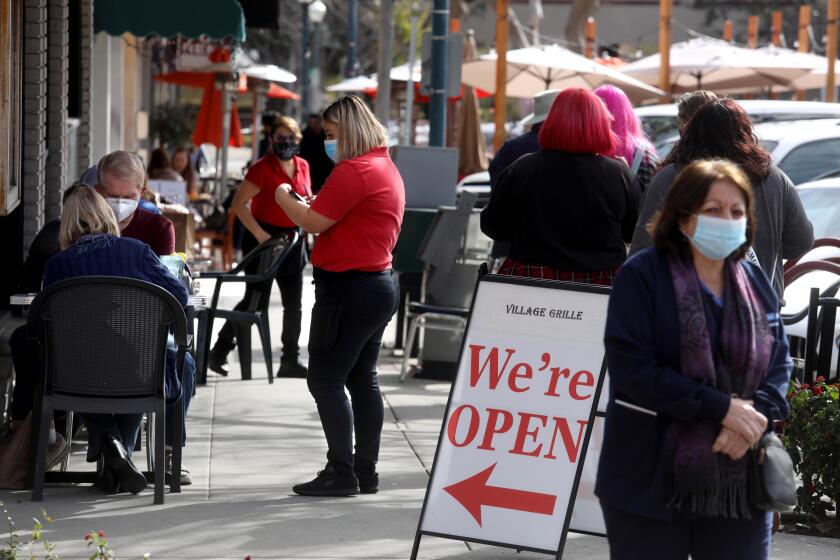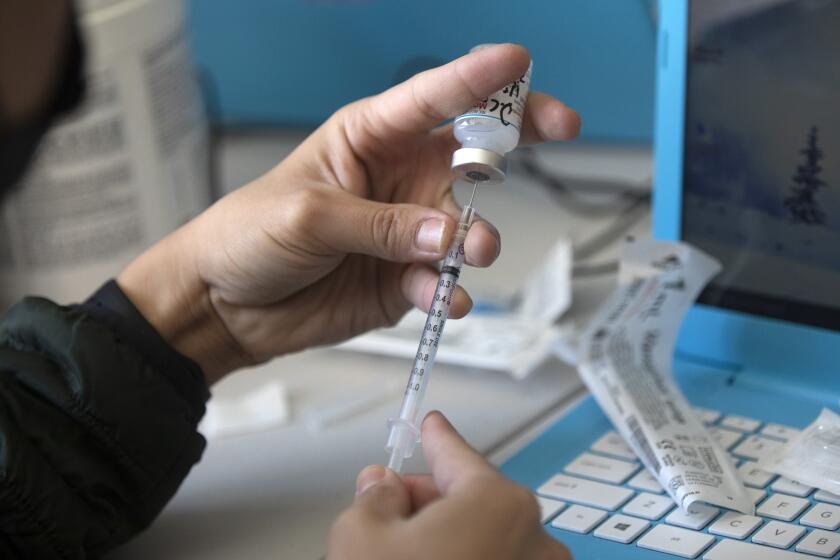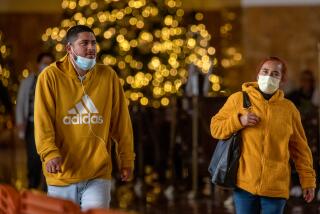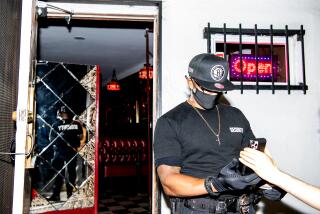L.A., Orange counties dramatically improve COVID rates, await word on major reopenings
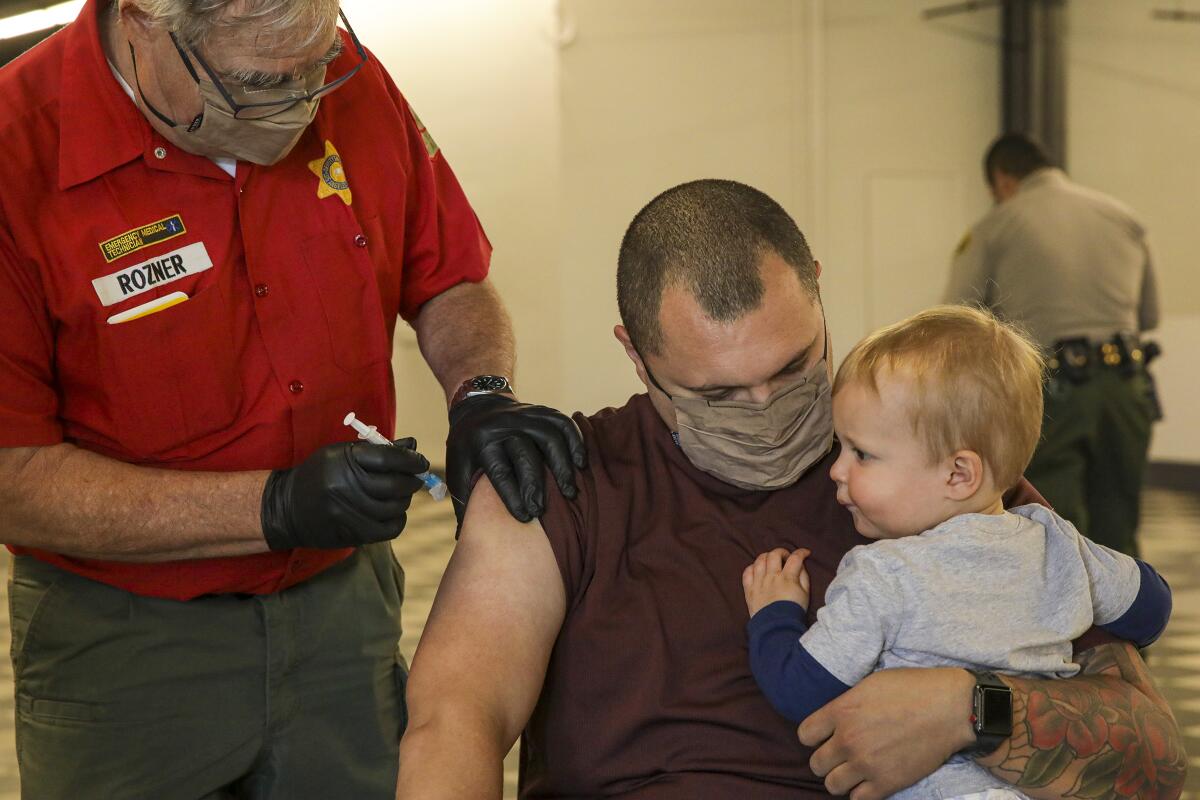
- Share via
Some of California’s biggest counties are now closer to a wider economic reopening than they’ve been in months, with only a smattering of strategically deployed COVID-19 vaccines standing between them and the ability to resume on-site dining and welcome additional students for on-campus learning.
According to new state data released Tuesday, Los Angeles, Orange and San Bernardino counties recorded coronavirus case rates low enough to enable them to escape the strictest, or purple, tier of California’s four-tier reopening roadmap. The timing of when they officially land in a less restrictive category, however, hinges on how quickly vaccine can be administered to residents of some disadvantaged areas.
The magic number of doses is 2 million. Once California has given that many vaccinations in targeted lower-income communities, the state will relax the criteria, which along with the lower case rates will allow those counties to move from purple to the more permissive red tier. The state’s goal is to administer more doses in the areas that fall into the lowest quartile of the California Healthy Places index, a socioeconomic measurement tool.
L.A. and Orange counties’ decline in the coronavirus spread paves the way for Disneyland and other Southern California theme parks to reopen soon.
Currently, counties must have an adjusted rate at or below 7.0 new coronavirus cases per day per 100,000 people to move into the red tier. After the state hits its 2-million dose goal, which likely will occur this week, counties with a case rate of up to 10 new cases per day per 100,000 people would become eligible for the red tier.
As part of this effort to address inequities in vaccine administration, California is now dedicating 40% of its available supplies for residents in the most disadvantaged areas.
That tweaked threshold positions California counties to more quickly lift the most stringent coronavirus-related restrictions on businesses and public spaces.
Under the existing criteria, none of L.A., Orange or San Bernardino counties would be in position to advance from the purple tier this week.
The potentially accelerated opening in parts of Southern California, including Orange County, is possible thanks to a revamp of California’s coronavirus reopening blueprint.
However, because all three have logged adjusted case rates of fewer than 10 new cases per day per 100,000 people for the last two weeks, it appears they will be allowed to move soon after the state clears its vaccination hurdle.
“Our understanding is that, within 48 hours of the state announcing the vaccine trigger has been met, L.A. County, along with other counties with qualifying case rates, would move into the red tier,” L.A. County Public Health Director Barbara Ferrer told the county Board of Supervisors Tuesday.
California is about 103,000 doses short of meeting its goal, according to the latest available state data.
The most recently released average coronavirus case rates, which are adjusted based on the number of tests performed, were 5.2 in L.A., 6.0 in Orange County and 6.7 in San Bernardino.
A month ago, the calculated case rates were 31.7 in Los Angeles County, 29.7 in Orange County and 32.7 in San Bernardino County.
Other areas of Southern California have seen similarly sharp declines and are also closing in on a potential move to the red tier. The latest state-tabulated adjusted case rates were 8.3 for Riverside County, 8.8 for San Diego County, 9.7 for Santa Barbara County and 9.1 for Ventura County.
However, all of those counties would need to record case rates below 10 for another week to be eligible to advance under the state’s relaxed criteria.
California has relaxed the threshold for some counties to exit the most restrictive category of the state’s four-tier, color-coded reopening roadmap.
Though the red tier is the second-strictest of California’s reopening plan, reaching that category still affords far wider opportunities for business and other activities to resume.
Counties in the red tier can allow indoor restaurant dining and movie theaters to reopen at 25% capacity or up to 100 people, whichever is less. In-person classes also would be allowed to resume for students in grades seven through 12.
Indoor gyms and dance and yoga studios can open at 10% capacity. Museums, zoos and aquariums can open indoor activities at 25% capacity, and nonessential stores and libraries can open at 50% capacity, up from 25%.
State officials also announced last week that amusement parks will be eligible to reopen, with restrictions, in red tier counties starting April 1 — meaning long-closed attractions like Disneyland, Universal Studios, Knott’s Berry Farm and Six Flags Magic Mountain in Southern California could be mere weeks away from once again welcoming visitors.
Capacity will be limited to 15% for parks in counties that are in the red tier, with the cap rising to 25% once a county progresses to orange and 35% upon reaching the most lenient tier, yellow. Attendance will be limited to in-state visitors.
The state’s rules serve only as a benchmark, though. Counties have the power to impose additional restrictions — meaning it’s not a given that a region will immediately reopen fully after it meets state requirements.
In L.A. County, for instance, Ferrer said that “we’re looking closely at the science to understand what practices help reduce community transmission of COVID-19.”
Everyone, she said, must remain “extraordinarily cautious, because we’ve been here before” — seemingly trodding a hopeful path only to see the coronavirus rebound with ferocious intensity.
“Let’s not get ourselves back in a risky situation that puts our progress on hold again,” she said. “But more importantly, this is really the time to keep each other alive so that we’re getting everybody vaccinated.”
It remains to be seen whether L.A. may opt to hold off when it comes to certain activities — such as indoor dining — but some county officials said they think the region would do well to follow the state’s guidelines.
“To be different than that right now, I think would cause confusion and probably a lot of anger because there are so many venues out there, entities that have really suffered,” Supervisor Janice Hahn said Tuesday.
Supervisor Kathryn Barger said she was concerned that having a patchwork of different rules could encourage “cross-county travel to participate in different activities.”
“It’s my hope that we will be able to align with the state’s rules so that our residents can see the clear path forward, our businesses are not at a disadvantage,” she said.
It’s OK to have small, maskless gatherings indoors if everyone is vaccinated, but the CDC still warns against nonessential travel.
Even without changes to the tier thresholds, nine counties were cleared to move into a less restrictive category this week.
Six — Alameda, Butte, Calaveras, Imperial, Santa Cruz and Solano — moved from the purple tier to the red.
Mariposa and Plumas counties moved from the red tier to the next orange tier, while Alpine County became the sole occupant of the yellow tier.
The progression of counties from tier to tier dovetails with California’s continued emergence from its devastating fall-and-winter coronavirus wave.
Over the last week, California has reported an average of 4,270 new coronavirus cases per day, a 37% decrease from two weeks ago, according to data compiled by The Times.
“We have returned to daily case numbers that are now what we call our pre-surge levels, and this is wonderful news,” Ferrer said. “But it’s critically important to remember that continuing declines are not inevitable.”
The number of coronavirus-positive patients in California’s hospitals has also plummeted, reaching 3,766 on Sunday, with 1,065 in intensive care units.
Both those figures are the lowest since mid-November.
Florida and California responded to the COVID-19 pandemic in vastly different ways, but comparing outcomes isn’t so simple. Here’s what the numbers tell us.
Along with the imminently reachable 2-million dose threshold, state officials have set a further goal of administering a total of 4 million COVID-19 vaccine doses to residents in targeted communities.
Once that happens, the state will further rewrite its reopening blueprint to make it easier for counties to enter both the orange and yellow tiers.
The threshold to progress to orange would be relaxed from a requirement of under 4.0 daily new cases per 100,0000 residents to under 6.0. Entering the yellow tier would necessitate an adjusted case rate below 2.0 daily new cases per 100,000 people, compared with the current requirement of less than 1.0.
It’s unclear how long it will take to hit the 4-million dose mark. Over the last week, providers throughout California have administered an average of 203,566 doses per day statewide, Times data show.
Gov. Gavin Newsom said Monday that the state is seeing “more and more progress every day as we’re reopening our economy and reopening our schools safely for in-person public instruction.”
“The light truly is bright at the end of this tunnel,” he said during a briefing in Tulare County.
More to Read
Sign up for Essential California
The most important California stories and recommendations in your inbox every morning.
You may occasionally receive promotional content from the Los Angeles Times.


